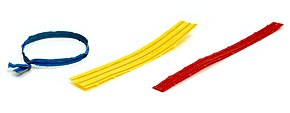Twist tie

A twist tie is a fastener made of one or more metal wires encased in a thin strip of paper or plastic, in such a way that it can bend and retain its shape. It is used to tie the openings of containers including bags, such as garbage bags or bread bags.[1][2] It is also called garden twist wire.[citation needed] A twist tie is used by wrapping it around the item to be fastened, then twisting the ends together.[1] They are often included with boxes of plastic food bags or trash bags, and are commonly available individually in pre-cut lengths, on large spools, or in perforated sheets called gangs.[2]
The outer covering can be in a variety of colors with or without printing.[1] Plain paper, metallic paper, plastic, poly, or custom coatings are popular for different applications.[1] The plastic, poly, or metallic paper twist ties withstand water better than the uncoated paper versions. Different sizes and strengths are used for different applications, from a small closure for a bag of bread to a large, heavy tie to hold unwieldy garden hoses in place. A twist tie with a broad paper covering may also be used for labeling.
The wire is often made of stainless steel or galvanized steel with a diameter between 19 and 31 (American standard wire gauge).[2]
See also
References
- ^ a b c d "What are Twist Ties?". Andfel Corporation. Andfel Corporation. Retrieved 11 September 2019.
- ^ a b c "New Trade Case on Imports of Twist Ties from China". JD Supra. June 29, 2020. Retrieved 30 June 2020.
